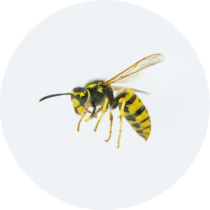Wasps
Actual Size : 6 mm to 10 mm long, with wingspans from 12 mm to 16 mm
Characteristics: Yellow, white, black, reddish. Have no hair on their abdomen, which is connected to their thorax with a thin petiole waist. Their head features mouthparts, sensory organs, compound eyes, and segmented antennae. Different wasp species have distinct markings.
Legs: 6
Antennae: Yes
Wings: Yes

Habitat
Wasp nests vary in shape, size and location depending on the species. Paper Wasps: Nests are constructed of paper-like material obtained by chewing and gluing plant material together. The nests are single layered, comb-like with no definable enclosure and consisting of 150 to 300 cells. The nests are stalked, attached to an object by a long stalks or stems called pedicel. Typical places where paper wasps attach their nests include fences, tree branches, twigs of trees and shrubs, eaves, door and window frames, exterior joists and soffits. Yellow Jackets and Hornets: Nests are also constructed of plant materials; however, they are multi-layered and consisting of five to nine combs with a total of 1,500 to 3,500 cells. The nests can either be exposed or protected in a paper envelope. Some yellow jack nests are the size of a soccer ball. Nests are typically found in hollow trees, wall voids, inside structures such as sheds, garages, and attics, and in trees and brushes. Some hornets and yellow jackets nest in ground. Ground nests are located typically in areas clear of vegetation. Mud daubers are solitary wasps. As the name suggests, mud daubers construct nests out of mud. A typical mud dauber nest is about 20-25 mm long. Such nests are generally plastered side by side forming a cluster of up to 100 to 120mm wide. Mud daubers like to build nests in sheltered sites, such as protected building structure and walls.


